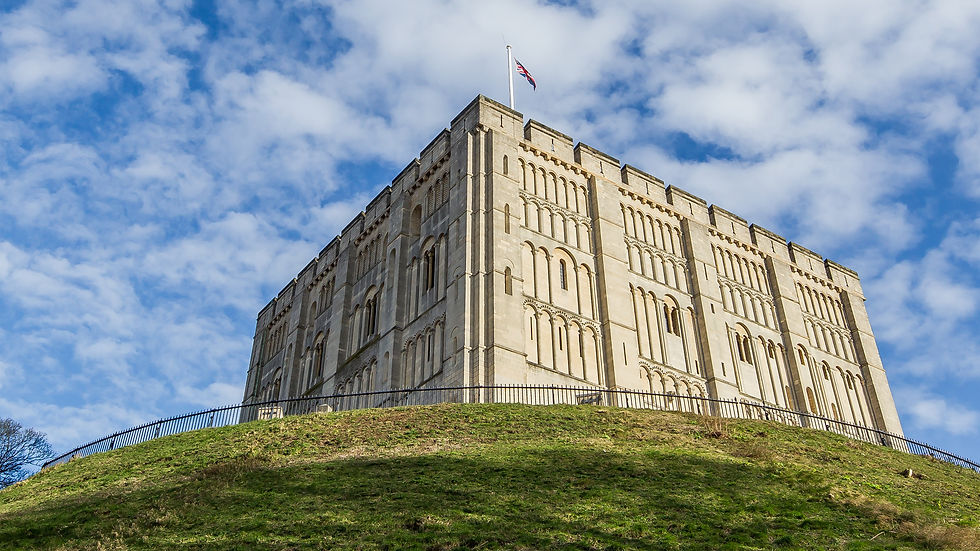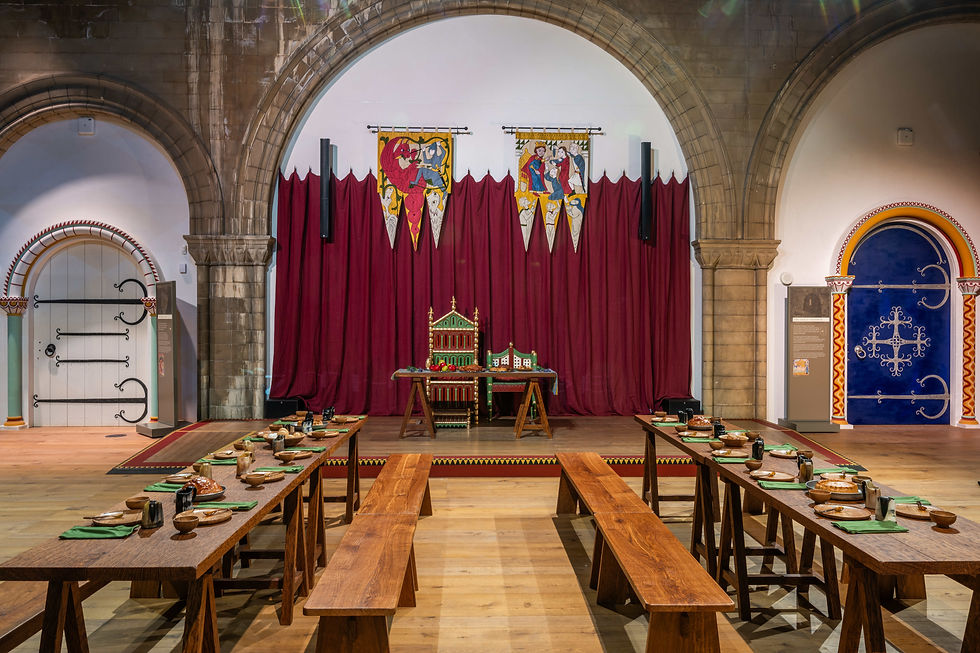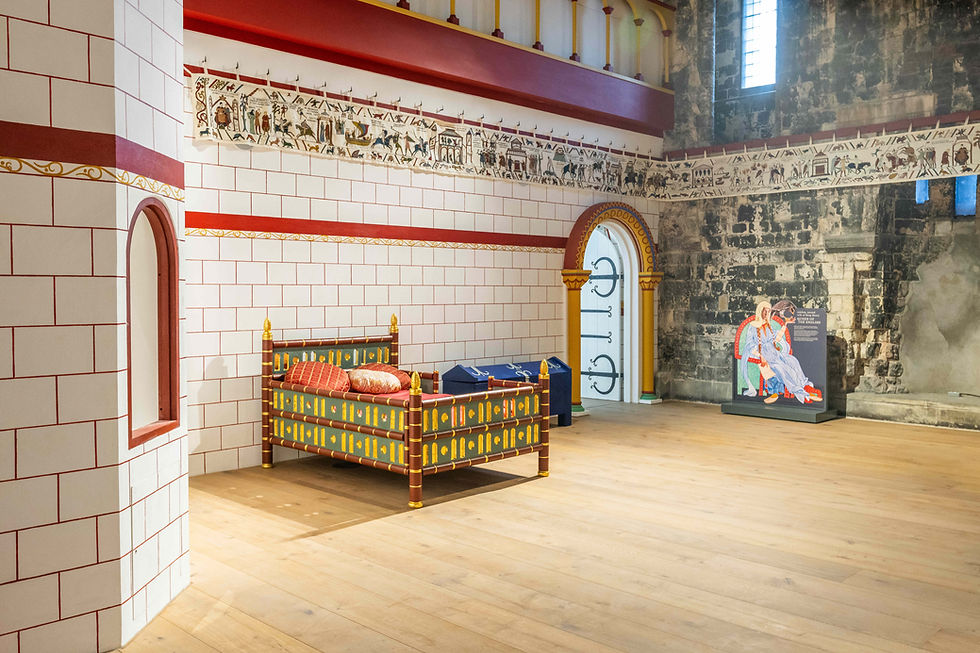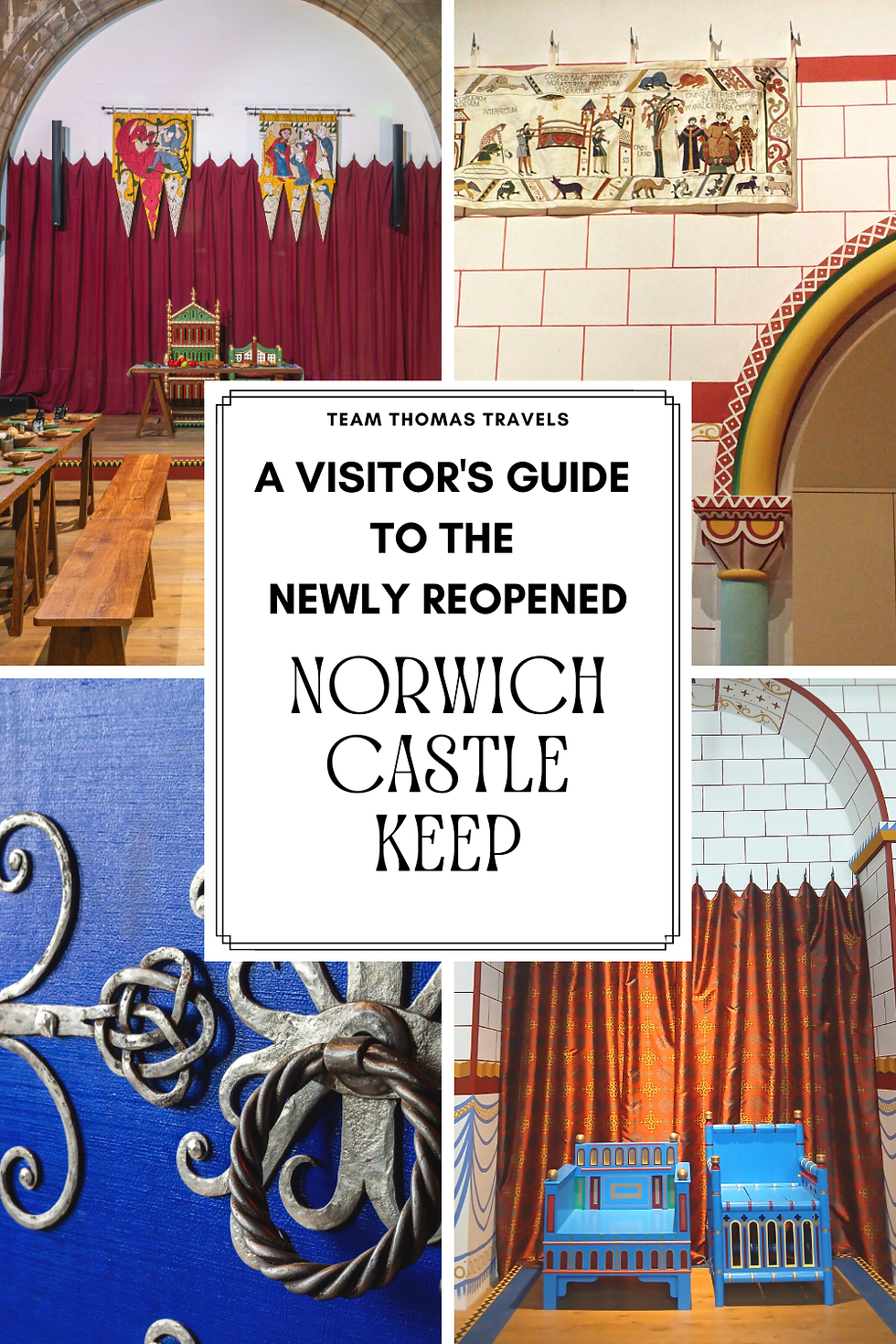Norwich Castle, you're a Keep-er! A visitor's guide to the newly opened Royal Palace
- teamthomastravels
- Aug 15
- 6 min read
After 5 years of extensive renovations and 10 years of ambitious plans, Norwich Castle, one of the finest medieval buildings in the UK has finally reopened to visitors!
Norwich Castle was commissioned by William the Conqueror, begun by one son, WIlliam Rufus and finished by another, King Henry I. It's unmistakeably Norman: big, square and perched imposingly on the highest castle mound in the country, this is a proper "now that's what you call a castle" castle.

The keep's £27.5 million transformation into authentic medieval royal palace was largely funded by a £13 million grant from the National Lottery Heritage Fund (so if you've bought a lottery ticket in the last 10 years you've helped make this incredible vision a reality!) and £12 million from the Norfolk County Council.
This week we were invited along to a press viewing to see what they've done with the place. I (Emma) was born in Norwich and have very fond childhood memories of visiting Norwich Castle Museum in the 90s, When I heard that the keep was finally ready to be unveiled, I was beyond excited to to introduce David and Jamie to it. And boy, was it worth the wait!
A Royal Palace Reborn
Entering the Castle keep via the museum's beautiful new glass roofed atrium (where you'll also find the new gift shop and cafe), we were immediately transported back 900 years into a sumptuous and unbelievably colourful 12th century royal palace. If you've visited Norwich Castle before, you won't believe the transformation -what was once a hollow shell with a balcony running around the inside has now been sympathetically and painstakingly accurately restored into fully furnished, stunning medieval rooms, just as they would have looked in 1121.

The Great Hall has been meticulously reinstated with an oak plank floor at its original height and a feast has been laid out on long trestle tables before a royal dias and two thrones. In the King's chamber, a luxurious bed is set beneath the Norwich Friends Tapestry: At 19 meters long, this beautifully embroidered imagined sequel to the Bayeux Tapestry was created by local volunteers to tell the stories of East England's rebellions against William the Conqueror. Next door, the chapel has been expanded to a more realistic size, with the amazing historic graffiti still preserved and visible and there is the new addition of a pair of electric blue replica thrones.
What struck us the most about the new Royal Palace was the explosion of colours: vibrant bright blue doors, pristine whitewashed walls crisscrossed with recreated red brick lines and historically accurate furniture painted in rich reds and greens. Even the spaces above the doors burst with cheerful green and yellow.

Impressively, every single decorative detail, textile pattern and colour choice is based on a real, contemporary 12th-century example - either a physical surviving object or an illustration from a historical document. Everything has been meticulously researched with an academic advisory board, ensuring that what you're looking at is truly authentic. And the results are spectacular!
Just a few examples of this incredible attention to detail include:
The red and white internal walls, based on churches found in Hertfordshire and Coombes, Sussex (though they also reminded us of the medieval frescoes we saw in Saint Ceneri Le Gerei, Normandy, which seems appropriate!).
The green bed blankets featuring lions and the tree of life are a recreation of a surviving piece of silk from 12th century Brussels.
The ironwork on the main entry door to the Great Hall is directly lifted from the design at Raveningham church, just 14 miles from the Castle.

People often imagine medieval castles to be dull, grey stone with torches and the odd tapestry on the walls, but this couldn't be further from the truth. Rather than a fortification built for war, this was a royal residence, and the Normans liked things to be a tad more fancy!
More East Anglian guides by us:
The most accessible castle in England
Another triumph of Norwich Castle's renovations is its improved accessibility: From the basement to the battlements, all five floors of the castle are now fully wheelchair and pushchair friendly, with lifts running all the way up to the castle's sunny roof. You can walk walk the entire battlements and take in stunning 360-degree views of Norwich Market and Norwich Cathedral—two more of the city's landmarks that have stood since the 12th century!
The keep is also wonderfully multisensory and interactive. A particular highlight is the glorious immersive projection that plays across the Great Hall's walls periodically throughout the day, telling the history of the castle through Romanesque style illustrations and surround sound.
If you'd like to get more hands on, there is armour to try on and weapons to handle, and for the younger visitors, a wardrobe of costumes, building blocks and books to enjoy. You can even sit on the throne!

Gallery of Medieval LIfe
Once you've finished exploring the royal palace, head down to the stunning Gallery of Medieval Life, a permanent display created in partnership with the British Museum. This is the largest medieval gallery of the British Museum's collection outside of London, showcasing over 900 artifacts from the Norman Conquest to the Dissolution of the Monasteries under KIng Henry VIII and frames Norfolk and East Anglia within the world of medieval Europe. Far from just focusing on nobility, the gallery also explores the lives of ordinary people, from everyday workers to the church and beyond, through three themed collections, named after how the medieval world saw society: Those who pray, those who fight and those who work.
This is an incredible range of objects, including exquisitely carved personal items and ancient weapons. Stand out artefacts include:
The Ashwellthorpe Triptych, an altarpiece painting that is the earliest known commission from a Flemish artist for a Norwich family, showing the region's long relationship with the Low Countries.
Two iron seal matrixes that belonged to King Henry V (when he was the Prince of Wales) and King Richard III (when he was Duke of Gloucester), used to seal documents.
A falchion, a rare type of single-edged sword that would have been used by medieval soldiers.
A stunning ivory bobbin found just metres away from its display case in a castle drain - dating from the 12th century it is beautifully carved with a human face and would have belonged to a wealthy noblewoman who lived in the castle when it was irst built - could it have been Queen Adeliza, King Henry I's wife?
A gold disc from a King Henry IV's bird of prey, giving a glimpse into the world of royal falconry.
A rare breach loading cannon, as dangerous for the user as the person it was aimed at, dredged up by a fishing boat off the Norfolk coast.
A collection of pilgrimage badges, giving a glimpse into the spiritual journeys of medieval people. Norfolk was home to two famous pilgrimage sites: the shrine to Our Lady of Walsingham, one of the most important pilgrimage destinations in medieval Europe, rivaling even Canterbury, and Bromholm Priory, said to possess a fragment of the True Cross of Christ's Crucifixion.

After a decade of ambitious plans and tireless work, Norwich Castle has been magnificently reborn. This is more than a restoration, it's a complete reimagining that brings one of England's finest medieval buildings back to life in spectacular fashion with every detail meticulously recreated for an authentic experience. Whether you're a history buff, a family looking for a day of adventure, or a local hoping to revisit a childhood favourite, Norwich Castle is an unforgettable experience for anyone who wants to see, feel, and touch history. We can't recommend a visit enough!
Useful information:
Address: Norwich Castle, Castle Street Norwich, NR41 3JU
Opening times: daily, 10am -5pm
Adult: Advanced online price - £15.30 / On the day - £17.00
Family discount adult (with a paid child ticket): Online price - £13.95 / on the day £15.50
Child (age 4-18): Online price - £13.05 / On the day - £14.50
Child under 4: Free
Your ticket is valid for entry to the Norman keep plus all the other museum galleries, such as Natural History, Romans, Anglo Saxons, Vikings, Fine Art and the Royal Norfolk Regimental Museum.
Norwich Castle is about 15 minutes walk from the train station. There are multiple car parks in Norwich city centre, but please be aware that Norwich Castle doesn't have car park.
Pin this blog for later!












